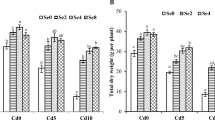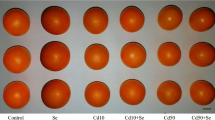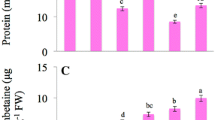Abstract
The aim of the present study was to examine the effects of exogenous selenium (Se) supplementation on the tolerance of pepper (Capsicum annuum L.) cv. Suryamukhi Cluster plants to cadmium (Cd) phytotoxicity at the reproductive stage. The pepper plants were supplied with Cd (0, 0.25 or 0.50 mM) and Se (0, 3 or 7 μM), individually or simultaneously, three times during the experiment. The obtained results show that Cd had deleterious effect on pepper plants at the reproductive stage. However, Se supplementation improved the flower number, fruit number and fruit diameter in plants exposed to 0.50 mM Cd. Moreover, both Se concentrations used in 0.25 mM Cd-treated plants and 3 μM Se in 0.50 mM Cd-treated plants enhanced fruit yield per plant as compared to Cd-alone treatment. The chlorophyll concentrations significantly increased in the fruits of Cd-exposed plants after Se addition. However, Se supplementation reduced total carotenoids and total soluble solid (TSS) concentrations in the pepper fruits exposed to Cd. Selenium also generally enhanced the total antioxidant activity of pepper fruits subjected to Cd. Both Se concentrations used increased mean productivity (MP), stress tolerance index (STI) and yield stability index (YSI) in plants grown in the medium containing 0.25 mM Cd. At low concentration (3 μM), Se significantly increased geometric mean productivity (GMP), STI and YSI of plant exposed to 0.50 mM Cd. The highest Cd concentration in the fruits was achieved at 0.50 mM Cd and Se application significantly reduced Cd accumulation in the Cd-exposed plants. Our results indicate that application of Se can alleviate Cd toxicity in pepper plants at the reproductive stage by restricting Cd accumulation in fruits, enhancing their antioxidant activity and thus improving the reproductive and stress tolerance parameters.






Similar content being viewed by others
Abbreviations
- DPPH:
-
2,2-diphenyl-1-picrylhydrazyl
- GMP:
-
Geometric mean productivity
- MP:
-
Mean productivity
- ROS:
-
Reactive oxygen species
- STI:
-
Stress tolerance index
- TSS:
-
Total soluble solids
References
Tran TA, Popova LP (2013) Function and toxicity of cadmium in plants: recent advances and future prospect. Turk J Bot 37:1–13
López-Millán AF, Sagrdoy R, Solanas M, Abadía A, Abadía J (2009) Cadmium toxicity in tomato (Lycopersicon esculentum) plants grown in hydroponics. Environ Exp Bot 65:376–385
Sanitá di Toppi L, Gabbrielli R (1999) Response to cadmium in higher plants. Environ Exp Bot 41:105–130
Gill SS, Tuteja N (2011) Cadmium stress tolerance in crop plants — probing the role of sulfur. Plant Signal Behav 6:215–222
Benavides MP, Gallego SM, Tomaro ML (2005) Cadmium toxicity in plants. Braz J Plant Physiol 17:21–34
Xin J, Huang B (2014) Subcellular distribution and chemical forms of cadmium in two hot pepper cultivars differing in cadmium accumulation. J Agric Food Chem 62:508–515
Larbi A, Morales F, Abadia A, Gogorcena Y, Lucena J, Abadia J (2002) Effects of Cd and Pb in sugar beet plants grown in nutrition solution: induced Fe deficiency and growth inhibition. Funct Plant Biol 29(12):1453–1464
Djebali W, Gallusci P, Polge C, Boulila L, Galtier N, Raymond P, Chaibi W, Brouquisse R (2008) Modifications in endopeptidase and 20S proteasome expression and activities in cadmium treated tomato (Solanum lycopersicum L.) plants. Planta 227:625–639
Belkhadi A, Hediji H, Abbes Z, Nouairi I, Barhoumi Z, Zarrouk M, Chaïbi W, Djebali W (2010) Effects of exogenous salicylic acid pre-treatment on cadmium toxicity and leaf lipid content in Linum usitatissimum L. Ecotoxicol Environ Safe 73:1004–1011
León AM, Palma JM, Corpas FJ, Gómez M, Romero Puertas MC, Chatterjee D, Mateos RM, del Río LA, Sandalio LM (2002) Antioxidative enzymes in cultivars of pepper plants with different sensitivity to cadmium. Plant Physiol Biochem 40:813–820
Gill SS, Tuteja N (2010) Reactive oxygen species and antioxidant machinery in abiotic stress tolerance in crop plants. Plant Physiol Biochem 48:909–930
Li F, Qi J, Zhang G, Lin L, Fang P, Tao A, Xu J (2013) Effect of cadmium stress on the growth, antioxidative enzymes and lipid peroxidation in two kenaf (Hibiscus cannabinus L.) plant seedlings. J Integr Agric 12(4):610–620
Kashem MDA, Kawai S (2007) Alleviation of cadmium phytotoxicity by magnesium in Japanese mustard spinach. Soil Sci Plant Nutr 53:246–251
Hassan MJ, Zhang G, Wu F, Wei K, Chen Z (2005) Zinc alleviates growth inhibition and oxidative stress caused by cadmium in rice. J Plant Nutr Soil Sci 168:255–261
Shi G, Cai Q, Liu C, Wu L (2010) Silicon alleviates cadmium toxicity in peanut plants in relation to cadmium distribution and stimulation of antioxidative enzymes. Plant Growth Reg 61:45–52
Hartikainen H, Ekholm P, Piironen V, Xue T, Koivu T, Yli-Halla M (1997) Quality of the ryegrass and lettuce yields as affected by selenium fertilization. Agric Food Sci Finl 6:381–387
Akbulut M, Cakir S (2010) The effects of Se phytotoxicity on the antioxidant systems of leaf tissues in barley (Hordeum vulgare L.) seedling. Plant Physiol Biochem 48:160–166
Hajiboland R, Keivanfar N (2012) Selenium supplementation stimulates vegetative and reproductive growth in canola (Brassica napus L.) plants. Acta Agric Slov 99(1):13–19
Xue T, Hartikainen H, Piironen V (2001) Antioxidative and growth-promoting effect of selenium on senescing lettuce. Plant Soil 237:55–61
Dajanaguiraman M, Durga Devi D, Shanker AK, Annie Sheeba J, Bangarusamy U (2005) Selenium an antioxidative protectant in soybean during senescence. Plant Soil 272:77–86
Turakainen M, Hartikainen H, Mervi MSN (2004) Effects of selenium treatments on potato (Solanum tuberosum L.) growth and concentrations of soluble sugars and starch. J Agric Food Chem 52:5378–5382
Lin L, Zhou W, Dai H, Cao F, Zhang G, Wu F (2012) Selenium reduces cadmium uptake and mitigates cadmium toxicity in rice. J Hazard Mater 235–236:343–351
Lyons GH, Genc Y, Soole K, Stangoulis JCR, Liu F, Graham RD (2009) Selenium increases seed production in Brassica. Plant Soil 318:73–80
Hawrylak-Nowak B (2009) Beneficial effects of exogenous selenium in cucumber seedlings subjected to salt stress. Biol Trace Elem Res 132:259–269
Hasanuzzaman M, Fujita M (2011) Selenium pretreatment upregulates the antioxidant defense and methylglyoxal detoxification system and confers enhanced tolerance to drought stress in rapeseed seedlings. Biol Trace Elem Res 143:1758–1776
Dajnaguiraman M, Prasad PVV, Sëppanen M (2010) Selenium protects sorghum leaves from oxidative damage under high temperature stress by enhancing antioxidant defence system. Plant Physiol Biochem 48:999–1007
Hasanuzzaman M, Hossain MA, Fujita M (2012) Exogenous selenium pretreatment protects rapeseed seedlings from cadmium-induced oxidative stress by upregulating antioxidant defense and methylglyoxal detoxification systems. Biol Trace Elem Res 149:248–261
Kumar M, Bijo AJ, Ravi S, Baghel CRK, Bhavanath JHA (2012) Selenium and spermine alleviate cadmium induced toxicity in the red seaweed Gracilaria dura by regulating antioxidants and DNA methylation. Plant Physiol Biochem 51:129–138
Filek M, Gzyl-Marlcher B, Zembala M, Bednarska E, Laggner P, Kriechbaum M (2010) Effect of selenium on characteristics of rape chloroplast modified by cadmium. J Plant Physiol 167:28–33
Kopsell DA, Kopsell DE (2006) Selenium. In: Barker AV, Pilbeam D (eds) Handbook of plant nutrition. CRS Press, Taylor & Frances Group, Boca Raton, pp 515–550
Barrietos EY, Flores CR, Wrobel K, Wrobel K (2012) Impact of cadmium and selenium exposure on trace element, fatty acids and oxidative stress in Lepidium sativum. J Mex Chem Soc 56:3–9
Bosland PW, Votava EJ (2012) Pepper: vegetable and spice Capsicums, 2nd edn. CABI Publishing, USA, p 230
Angelova VR, Babrikov TD, Ivanov KI (2009) Bioaccumulation and distribution of lead, zinc, and cadmium in crops of Solanaceae family. Commun Soil Sci Plant Anal 40:2248–2263
Jones JB (1930) Hydroponics: a practical guide for the soilless grower, 2nd edn. CRC Press, Boca Raton, p 439
Hiscox JD, Israelstam GF (1979) A method for the extraction of chlorophyll from leaf tissue without maceration. Can J Bot 57:1332–1334
Koleva II, van Beek TA, Linssen JPH, de Groot A, Evstatieva LN (2002) Screening of plant extracts for antioxidant activity: a comparative study on three testing methods. Phytochem Anal 13:8–17
McDonald S, Prenzler PD, Antolovich M, Robards K (2001) Phenolic content and antioxidant activity of olive extracts. Food Chem 73:73–84
Haghighi M, Kafi M, Fang P, Gui-Xiao L (2010) Humic acid decreased hazardous of cadmium toxicity on lettuce (Lactuca sativa L.). Veg Crops Res Bul 72:49–61
Farshadfar E, Poursiahbidi MM, Safavi S (2013) Assessment of drought tolerance in land races of bread wheat based on resistance/tolerance indices. Int J Adv Biol Biom Res 12:143–158
Hédiji H, Djebali W, Cabasson C, Maucourt M, Baldet P, Bertrand A, Zoghlami LB, Deborde C, Moing A, Chaïbi W, Gallusci P (2010) Effects of long-term cadmium exposure on growth and metabolomic profile of tomato plants. Ecotoxicol Environ Safe 73:1965–1974
Garcia-Bañuelos ML, Hermosillo-Cereceres MA, Sánchez E (2011) The importance of selenium biofortification in food crops. Curr Nut Food Sci 7:181–190
Liu Y, Zang SP, Cai YQ (2010) Cytoprotective effect of selenium on cadmium-induced LLC-P1 cells apotosis by activating JNK pathway. Toxicol in Vitro 21:677–684
Yassen AA, Safia M, Sahar A, Zaghloul M (2011) Impact of nitrogen fertilizer and foliar spray of selenium on growth, yield and chemical constituents of potato plants. Aust J Basic Appl Sci 5:1296–1303
Wang Y, Wang X, Wong Y (2013) Generation of selenium-enriched rice with enhanced grain yield, selenium content and bioavailability through fertilisation with selenite. Food Chem 141:2385–2393
Pezzarossa B, Rosellini I, Borghesi E, Tonutti P, Malorgiob F (2014) Effects of Se-enrichment on yield, fruit composition and ripening of tomato (Solanum lycopersicum) plants grown in hydroponics. Sci Hortic 22:106–110
Hladun KR, Parker DR, Trumble JT (2011) Selenium accumulation in the floral tissues of two Brassicaceae species and its impact on floral traits and plant performance. Environ Exp Bot 74:90–97
Cartes P, Jara A, Pinilla L, Rosas A, Mora M (2010) Selenium improves the antioxidant ability against aluminium-induced oxidative stress in ryegrass roots. Ann Appl Biol 156:297–307
Fu Q, Hu H, Li J, Huang L, Yang H, Lv Y (2009) Effects of soil polluted by cadmium and lead on production and quality of pepper (Capsicum annuum L.) and radish (Raphanus sativus L.). J Food Agric Environ 7:698–702
Wu GL, Ning CJ (2013) Effects of applying selenium to Chinese jujube on the fruit quality and mineral elements content. Acta Hort (ISHS) 993:199–207
Sally M, Mervat S (2011) Some antioxidants application in relation to lettuce growth, chemical constituents and yield. Aust J Basic Appl Sci 5:127–135
Pezzarossa B, Remorini D, Gentile ML, Massai R (2012) Effects of foliar and fruit addition of sodium selenate on selenium accumulation and fruit quality. J Sci Food Agric 92:781–786
Saidi I, Chtourou Y, Djebali W (2014) Selenium alleviates cadmium toxicity by preventing oxidative stress in sunflower (Helianthus annuus) seedlings. J Plant Physiol 171:85–91
Hawrylak-Nowak B, Dresler S, Wójcik M (2014) Selenium affects physiological parameters and phytochelatins accumulation in cucumber (Cucumis sativus L.) plants grown under cadmium exposure. Sci Hortic 172:10–18
Feng R, Wie C, Tu S (2013) The roles of selenium in protecting plants against abiotic stresses. Environ Exp Bot 87:58–68
Pedrero Z, Madrid Y, Hartikainen H, Cámara C (2008) Protective effect of selenium in broccoli (Brassica oleracea) plants subjected to cadmium exposure. J Agric Food Chem 56:266–271
Safaryazdi A, Lahouti M, Ganjeali A, Bayat H (2012) Impact of selenium supplementation on growth and selenium accumulation on spinach (Spinacia oleraceae L.) plants. Not Sci Biol 4:95–100
Chen TF, Zheng WJ, Wong YS, Yang F (2008) Selenium-induced changes in activities of antioxidant enzymes and content of photosynthetic pigments in Spirulina platensis. J Integr Plant Biol 50:40–48
Hawrylak-Nowak B (2008) Enhanced selenium content in sweet basil (Ocimum basilicum L.) by foliar fertilization. Veg Crop Res Bull 69:63–72
Chu J, Xiaoqin Y, Zhuona Z (2010) Responses of wheat seedlings exogenous selenium supply under cold stress. Biol Trace Elem Res 136:355–363
Ríos JJ, Rosales MA, Blasco B, Cervilla LM, Romero L, Ruiz JM (2008) Biofortification of Se and induction of the antioxidant capacity in lettuce plants. Sci Hortic 116:248–255
Sivaci A, Sivaci ER, Sökmen M (2007) Changes in antioxidant activity, total phenolic and abscisic acid constituents in the aquatic plants Myriophyllum spicatum L. and Myriophyllum triphyllum Orchard exposed to cadmium. Ecotoxicology 16:423–428
Siddiqui MM, Abbasi BH, Ahmad N, Ali M, Mahmood T (2014) Toxic effects of heavy metals (Cd, Cr and Pb) on seed germination and growth and DPPH-scavenging activity in Brassica rapa var. turnip. Toxicol Ind Health 30:238–249
Hartikainen H, Xue T, Piironen V (2000) Selenium as an anti-oxidant and pro-oxidant in ryegrass. Plant Soil 225:193–200
Duan YX, Fu TZ (1979) The absorption of Se by garlic and the effect of Se on the growth of garlic. Guangdong Trace Elem Sci 4:52–55
Xu J, Yang F, Chen L, Hu Y, Hu U (2003) Effect of selenium on increasing the antioxidant activity of tea leaves harvested during the early spring tea producing season. J Agric Food Chem 51:1081–1084
Dayang SN, Che Fauziah I, Umi Kalsom Y (2012) Influence of selenium on the antioxidant activity of Mas cotek (Ficus deltoidea) as affected by soil acidity and phosphorus (P) fertilization. J Med Plants Res 6:5662–5668
Xin J, Huang B, Liu A, Zhou W, Liao K (2013) Identification of hot pepper cultivars containing low Cd levels after growing on contaminated soil: uptake and redistribution to the edible plant parts. Plant Soil 373:415–425
Feng R, Wei C, Tu S, Ding Y, Song Z (2013) A dual role of Se on Cd toxicity: evidences from the uptake of Cd and some essential elements and the growth responses in paddy rice. Biol Trace Elem Res 151:113–121
Author information
Authors and Affiliations
Corresponding author
Rights and permissions
About this article
Cite this article
Mozafariyan, M., Shekari, L., Hawrylak-Nowak, B. et al. Protective Role of Selenium on Pepper Exposed to Cadmium Stress During Reproductive Stage. Biol Trace Elem Res 160, 97–107 (2014). https://doi.org/10.1007/s12011-014-0028-2
Received:
Accepted:
Published:
Issue Date:
DOI: https://doi.org/10.1007/s12011-014-0028-2




